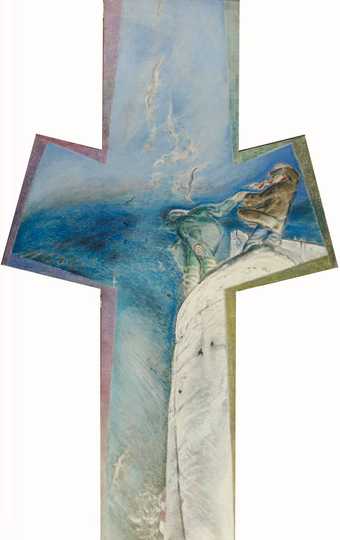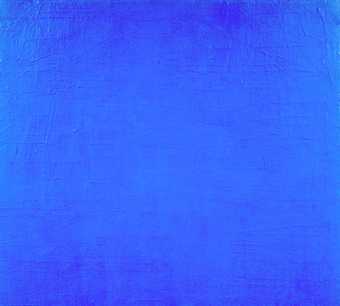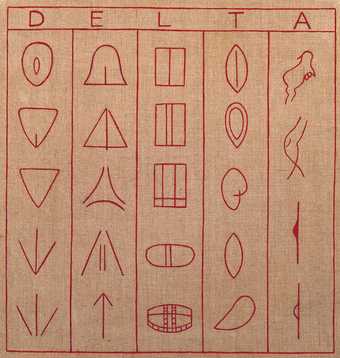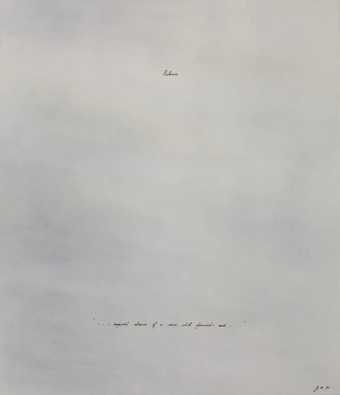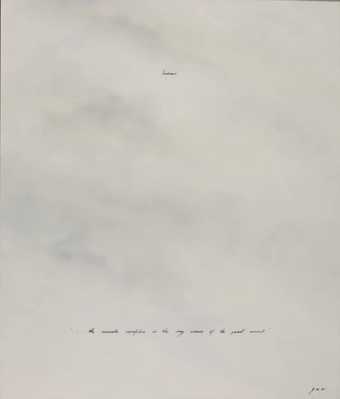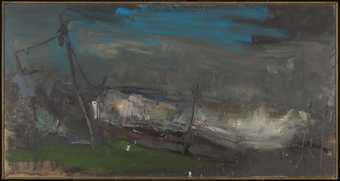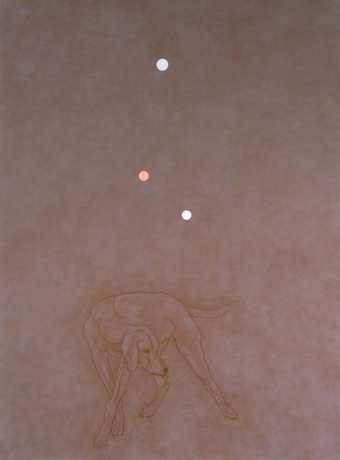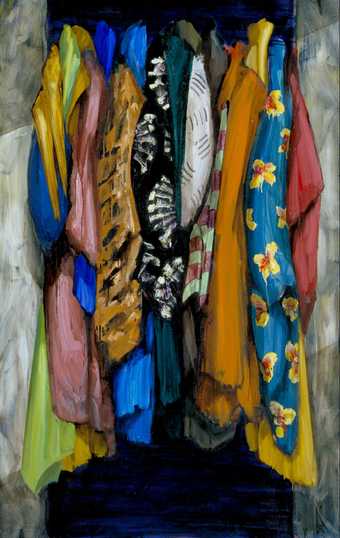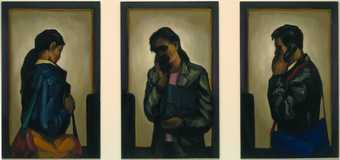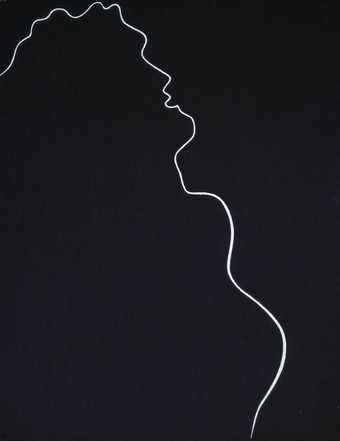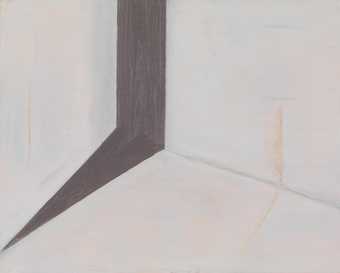
Not on display
- Artist
- Laetitia Yhap born 1941
- Medium
- Oil paint on board
- Dimensions
- Support: 1205 × 1496 mm
frame: 1200 × 1496 × 55 mm - Collection
- Tate
- Acquisition
- Presented by the Trustees of the Chantrey Bequest 1984
- Reference
- T03930
Catalogue entry
Laetitia Yhap born 1941
T03930 Michael Balling up Old Net
1984
Oil on plywood and acrylic on integral softwood surround 1205 x 1496 (47 1/2 x 58 7/8)
Inscribed ‘Michael | ‘balling-up' | old net. | 1984 | (drawing done '83-84)' on back towards t.r., ‘Laetitia Yhap' and artist's address, b.l. and ‘from a drawing | done in | Dec | 118cmx150cm' towards lower centre beneath other cancelled inscriptions (see below)
Presented by the Trustees of the Chantrey Bequest 1984
Prov: Purchased from the artist by the Trustees of the Chantrey Bequest 1984
Exh: Laetitia Yhap, AIR Gallery, April 1984 (12); The Hard-Won Image, Tate Gallery, July-Sept.1984 (149); RA, 1985 (1241, repr. RA Illustrated, p.30); Laetitia Yhap The Business of the Beach Paintings and Drawings 1976-1988, Laing Art Gallery, Newcastle-upon-Tyne, Aug.-Sept.1988, Newlyn Art Gallery, Sept.-Oct. 1988 (12, repr.).
All quotations, unless otherwise indicated, are taken from a letter to the cataloguer from the artist, received on 25 February 1988.
In 1968 Laetitia Yhap moved from London to Hastings in Sussex. At the time, Yhap worked primarily in watercolour and tempera on compositions usually centred around a still-life theme, such as the watercolour entitled ‘Sprouting Broccoli' 1971 (repr., Laetitia Yhap, exh. cat., Piccadilly Gallery, 1971 on front cover). Yhap describes how ‘For years I felt unable to depict people. The insubstantial was my subject matter. The raindrop - the rainbow - a withered leaf ... the idea of the window pane as a screen' (‘Artists statement' in Laetitia Yhap, exh. cat., Serpentine Gallery, 1979, [p.1]). She did not begin painting the fishing community in Hastings until 1973-4 when her work took on a new concern with the human figure: ‘What I value most in the great Art of the past is the recurring human image.' (Laetitia Yhap in Laetitia Yhap Painting and Drawings, exh. cat. Hastings Museums & Art Gallery, 1979 [2].)
Yhap became engrossed with the fishing community and soon noticed a transformation in her painting. In ‘The Artists thoughts on the 70s in Words and Pictures', (Studio International, vol.195, nos 991/2 1981, p.72) she describes how she watched and drew the ‘beach community' and how gradually ‘It followed that my life and painting metamorphosed and I began to find it possible to mend the break between my admiration for the humanist art of the past and my own vision'.
‘Michael Balling up Old Net' was painted in 1984 in the artist's studio in 12, The Croft, Hastings. The setting is a beach in Hastings known locally as ‘The Stade'. The particular part of the beach Yhap selected is the area around the lifeboat house - the wall of which is shown on the right.
The figure who is rolling up the net is Michael Rycroft, a full time fisherman who lives with the artist. At the time of painting ‘Michael Balling up Old Net' the artist was pregnant with their child, who was born a few months after the work was completed. This is the first painting in which Michael appears. On his upper arm is a tattoo of a sailing ship with clouds.
The young boy on the bicycle is called Wayne. At the time Yhap was painting T03930 Wayne was working as crew for various people at weekends and during school holidays. The artist is unsure of the identification of the two figures dressed in shorts and tee-shirts but thinks that they were probably full-time fishermen named Bossum and Timmy. The spaniel lying in the foreground, called Butch, belonged to Bossum.
Michael owned the net which he is seen working on. The process known as ‘balling up' is described by Yhap:
The whole business of making nets is intensive and repetitive. They are thousands of yards long and cost several hundreds of pounds in materials. When they are worn out it is often possible to cut out the ‘inners' and save the ‘wallings' (outsides) and fit a new net between the lead line and the corkline. It means that this work is often done in summer when there is no fishing going on and it can be done in a leisurely fashion - a way of making use of long summer days. From my point of view it means that people will be in the same place for several hours and I can contemplate the situation and draw also in a more leisurely way than when what I am watching is of a momentary nature.
For me the business of net making seems akin to the work of the spider. It is a web to catch prey and its size in relation to the creature who makes it is immense. I have not yet managed to express this aspect in any painting.
In this painting I suppose it was the idea of rolling the waste into a ball which sparked my imagination - the wrecked web - endless.
The canvas had previously been used for another work, as the artist commented in response to a questionnaire of February 1985 from the Tate Gallery Conservation Department. A painting was begun and abandoned probably in Liquitex - the board was then primed again with a mixture of Liquitex and a beaten egg yolk. This explains the cancelled inscription on the back of the canvas bottom left: ‘B.O.&Mark | Marking Leads | in | winter | begun in 1980(2)Feb'.
When asked about the unusual shaped frame and it being an integral part of the work, Yhap replied:
The frame was experimental but it is integral. I asked the boatbuilder to steam my pieces of wood in his steamer when he had an odd moment. Normally I use pieces which are already treated or I bend plywood or use found objects. The structure is completed before the painting is begun.
My idea of frames is to make them integral, not something added afterwards, the drawing room touch. I feel that the roughness of the completed object is part of its truth to my experience of the motifs. In practical terms I build the stretchers specifically for each painting and ‘the frame' is just the outside edge. It is what will contain the surface on which I am to paint, not an ‘ornament', not a thing to make the painting more like a piece of furniture, not to make it comfortable, but to stress its being as a painting.
I have always made my own structures since I was an art student at the Slade.
... I never saw the necessity for rectangular shapes once I turned my attention to ‘the museum without walls'. I do not think of myself as an ‘easel' painter. My paintings are hanging on the wall when I paint them. I was and am greatly affected by Italian fresco painting which is always part of an architecture. I was and am affected by chinese painting wherein
the image floats. The sources are endless. When I have an idea to be worked out in paint it does not sit in my mind's eye as a rectangle. It has an autonomy which somehow has to be interpreted. The shape I construct as a surface to work on is crucial, as that is what makes it possible to compose the painting or helps it to compose itself.
An undated drawing entitled ‘Balling up Old Net' was exhibited at RA 1984 (no.355) and reproduced in RA Illustrated, 1984, p.74. Yhap recalls that ‘odd scribbles' which relate to the painting were made but remembers that the above mentioned drawing was worked on after the painting was finished.
This entry has been approved by the artist.
Published in:
The Tate Gallery 1984-86: Illustrated Catalogue of Acquisitions Including Supplement to Catalogue of Acquisitions 1982-84, Tate Gallery, London 1988, pp.306-7
Explore
- objects(23,571)
-
- agriculture, gardening & fishing(951)
-
- fishing net(124)
- tattoo(45)
- boy(1,153)
- Bossum(1)
- Rycroft, Michael(1)
- Timmy(1)
- individuals: male(1,841)
- UK cities, towns and villages(12,725)
- Sussex - non-specific(1,805)
- Sussex, East(1,281)
- England(19,202)
- England, South East(5,940)
- England, Southern(8,982)
- transport: land(2,189)
-
- bicycle(196)
- agriculture and fishing(1,275)
You might like
-
Jeffery Camp Beachy Head: Brink
1975 -
Gilbert Spencer The Progress of Husbandry
c.1964 -
John Murphy The Blue Veil
1970 -
John Murphy Delta
1978–9 -
John Murphy Silence ’... augural abscence of a voice which fascinates and ...’
1980 -
Joan Eardley Salmon Net Posts
c.1961–62 -
Jeffery Camp Southcoast
1990 -
John Murphy An Indefinable Odour of Flowers Forever Cut
1982–4 -
John Murphy Investigations of a Dog (Pictor)
1984–96 -
Colin Smith Wardrobe 16
1995–7 -
Colin Smith Network 5
1996–7 -
John Murphy The Gathering Anguish Strikes Beneath ...
1982–3 -
Vicken Parsons Untitled
2005 -
Vicken Parsons Untitled
2012

